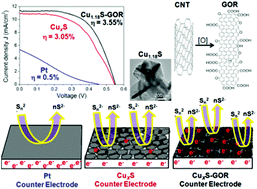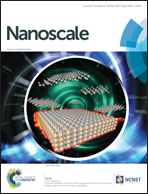A microwave synthesized CuxS and graphene oxide nanoribbon composite as a highly efficient counter electrode for quantum dot sensitized solar cells†
Abstract
To boost the photoconversion efficiency (PCE) of ever promising quantum dot sensitized solar cells (QDSSCs), and to improve the design of photoanodes, the ability of the counter electrode (CE) to effectively reduce the oxidized electrolyte needs special attention. A composite of a 15 wt% graphene oxide nanoribbon (GOR), obtained by unzipping multi-walled carbon nanotubes (MWCNTs), and CuxS intersecting hexagonal nanoplates, synthesized by a low cost, facile and scalable microwave synthesis route, is reported as a fascinating CE for QDSSCs. The best performing Cu1.18S–GOR CE could notably achieve a record PCE of ∼3.55% for CdS sensitized QDSSCs, ∼5.42% for in situ deposited CdS/CdSe co-sensitized QDSSCs and ∼6.81% for CdTe/CdS/CdS dual sensitized QDSSCs, apart from increasing the PCE of previously reported QDSSCs. A systematic investigation of the CE design revealed the high electrocatalytic activity of GOR due to the presence of organic functional groups, graphitic edge sites and a quasi-one-dimensional (quasi-1D) structure, which increases the interfacial charge transfer kinetics from the CE to the polysulfide electrolyte. The highly stable Cu1.18S–GOR CE has the added advantage of a favourable energy band alignment with the redox potential of the polysulfide electrolyte, which reduces the loss of charge carriers and thus can increase the PCE of QDSSCs.


 Please wait while we load your content...
Please wait while we load your content...